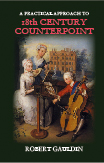“The new edition is comprehensive and detailed with effective step-by-step analysis and guidance. It is also surprisingly concise. The compact size of the book and the very reasonable price are attractive features.” — John Haek, Marylhurst University
“It seems to be a refreshing approach to a sometimes tiring subject for students. I appreciate the advanced analysis in place of simple score insertion. The layout is logical and the cost is reasonable.” — Gregory Hoepfner, Cameron University

335 pages, $62.95 list
1-4786-0470-0
978-1-4786-0470-9
© 2013
plastic comb
eBook availability
A Practical Approach to 18th Century Counterpoint, Revised Edition
Practical work in writing counterpoint! This volume emphasizes developing analytical and writing skills in the contrapuntal technique of the eighteenth century. The orientation is strongly stylistic, dealing mainly with the polyphony of the late Baroque period. Three aspects are stressed throughout: practical work in writing counterpoint, utilizing various textures, devices, and genre of the period; historical background, to establish the origins of different forms and justify the pedagogical method employed here; analysis of selections from music literature, often in voice-leading reductions. After an opening chapter that reviews some general features of the late Baroque period, there is a brief survey of melodic characteristics, and a study of procedures associated with two, three, and four voices.
Reactions
1. Introduction
2. Melody
3. General Characteristics of Counterpoint; Pedagogical Foundations
4. Two-Voice Note-Against-Note Counterpoint
5. Simple Diminution; 2:1 Elaboration of the Counterpointing Voice
6. Further Rhythmic Diminution; Two-Voice Chorale Preludes
7. Free Counterpoint; Simple Two-Reprise Form
8. Further Diminution Techniques in Two-Voice Texture
9. Real Imitation and Double Counterpoint
10. The Two-Part Canon and Invention
11. Introduction to Three-Voice Texture; Note-Against-Note and Simple Diminution
12. Further Rhythmic Diminution; Three-Voice Chorale Preludes
13. Chromaticism
14. Free Counterpoint in Three Voices; Extended Two-Reprise Forms
15. Tonal Imitation; Further Studies in Invertible Counterpoint
16. Additional Contrapuntal Devices; Further Study of Canon
17. The Three-Voice Fugue
18. Introduction to Four-Voice Texture; Further Study in Chorale Prelude
19. Variations
20. Further Studies in Fugue
21. Choral Writing
22. The Pedagogical Foundations of Counterpoint in the Classical Period
23. Examples of Counterpoint in the Classical Period
Appendix: Characteristics of Dance Movements
Bibliography
Textbooks
Treatises
Other Reference Sources
2. Melody
3. General Characteristics of Counterpoint; Pedagogical Foundations
4. Two-Voice Note-Against-Note Counterpoint
5. Simple Diminution; 2:1 Elaboration of the Counterpointing Voice
6. Further Rhythmic Diminution; Two-Voice Chorale Preludes
7. Free Counterpoint; Simple Two-Reprise Form
8. Further Diminution Techniques in Two-Voice Texture
9. Real Imitation and Double Counterpoint
10. The Two-Part Canon and Invention
11. Introduction to Three-Voice Texture; Note-Against-Note and Simple Diminution
12. Further Rhythmic Diminution; Three-Voice Chorale Preludes
13. Chromaticism
14. Free Counterpoint in Three Voices; Extended Two-Reprise Forms
15. Tonal Imitation; Further Studies in Invertible Counterpoint
16. Additional Contrapuntal Devices; Further Study of Canon
17. The Three-Voice Fugue
18. Introduction to Four-Voice Texture; Further Study in Chorale Prelude
19. Variations
20. Further Studies in Fugue
21. Choral Writing
22. The Pedagogical Foundations of Counterpoint in the Classical Period
23. Examples of Counterpoint in the Classical Period
Appendix: Characteristics of Dance Movements
Bibliography
Textbooks
Treatises
Other Reference Sources